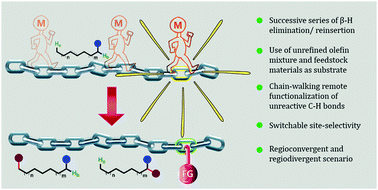Chain-walking reactions of transition metals for remote C–H bond functionalization of olefinic substrates
Abstract
Past several decades have witnessed the great evolution of inert C–H bond functionalization reactions as an emerging technique for synthesizing drug molecules, agrochemicals, and functional materials with intricate three-dimensional architectures. Although most activation of “unreactive” C–H bonds was accomplished by exploiting the power of transition metal catalysts, the distant and selective activation of unreactive C–H bonds in an undirected fashion remains one of the critical challenges to this rapidly growing field of organic chemistry. In this context, to meet all these concerns, much more attractive and challenging transition metal catalytic transformations have begun to blossom in recent years with the aid of the chain-walking process. The chain-walking strategy is one of the state-of-the-art techniques in organic synthesis to functionalize the unreactive C–H bonds by allowing the movement of a metal complex along the hydrocarbon chain of the substrate to recognize preferable bond-forming sites. The essential advantage of this strategy is that the bonds are formed only at the places where the catalyst selects for the specific C–H bonds to be cleaved, which not only avoids tedious synthetic procedures for prefunctionalization and the emission of undesirable wastes but also inspires chemists to plan novel synthetic strategies in a completely different manner. Consequently, various C–H bond functionalization reactions have been reported in recent years, employing the vast opportunity provided by this growing field mainly for the acyclic olefinic systems with flexible alkyl chains. Thus, chain-walking reactions allow the reactivity of the reaction centers within the substrates that cannot be realized via the classical mode of reactivity of the substrates. Applying this approach, inexpensive feedstock materials and simple hydrocarbons as an isomeric mixture can be converted to a single isomeric product in a regioconvergent scenario. Simultaneously, the site-selectivity of these reactions can also be switched using a regiodivergent strategy via appropriate tuning of ligands or a slight modification of reaction conditions. Herein, we have provided a comprehensive overview of the chain-walking reactions involving a variety of catalytic systems ranging from the first-row transition metal catalysts to the third-row transition metal catalysts for C–H activation in a concise fashion with the hope for further developments in this area through the appropriate application of the chain-walking reactions.

- This article is part of the themed collection: Functionalization of unreactive C-H bonds


 Please wait while we load your content...
Please wait while we load your content...